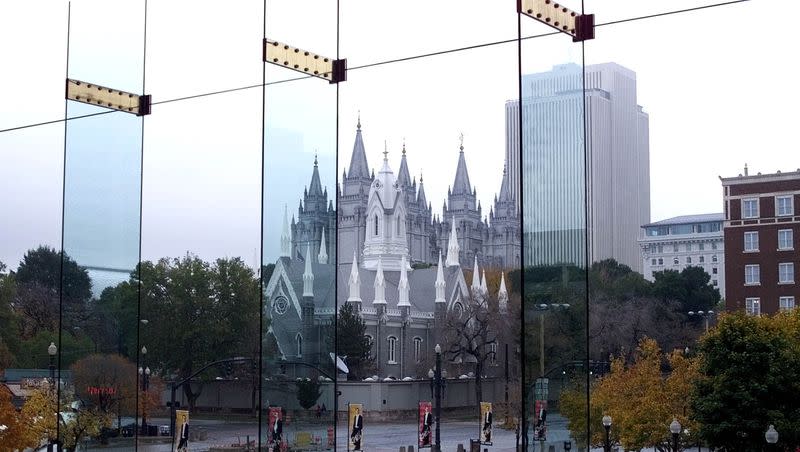What the Beehive State’s high rate of weekly religious attendance means

Utah has the highest rate of weekly attendance at church in the country. That’s according to data scientist Ryan Burge, who posted a graph on social media showing weekly attendance trends in the U.S. and Canada.
Using data from the European Social Survey and the Cooperative Election Study, Burge was able to calculate the overall weekly attendance rate of the U.S. and Europe. The average weekly attendance rate in the U.S. is 25%, while Europe has a 14% attendance rate.
Poland, a country known for its large Catholic population, has the highest rate of weekly attendance, at 44%, out of any U.S. state or European country. Utah ranks second at 41%.
Related
Deep South states like Mississippi, Alabama and Arkansas report relatively high rates of weekly attendance. The state in the U.S. with the lowest rate is New Hampshire at 12%. There are 20 European countries, including France, Denmark, Great Britain and others, at the same rate of attendance as New Hampshire or lower.
This is survey data on religious attendance. All fifty states are included, as well as many countries in Europe.
The overall weekly attendance rate:
US - 25%
Europe - 14%
44% of Poles report weekly attendance. Higher than any state.
It's 3% of Danes. Lower than any state. pic.twitter.com/Rz5vgC3k1Q— Ryan Burge 📊 (@ryanburge) August 30, 2023
While trends related to belief in God and attendance at religious services have dipped downward over the last couple decades, a quarter of the country still attends religious services weekly.
“But among those who still affiliate with a religious tradition, there’s fairly compelling evidence that their religiosity is at least as high as it was 40 years ago,” Burge wrote in a 2022 Deseret Magazine article. “And, in some cases, they are more devout than Christians from the 1970s.”
Here’s a closer look at what data shows us about those who attend weekly services in the U.S. and in Utah, and what religious attendance can do for a society.
Related
What are patterns among those who attend weekly services?
Among those who attend church in the U.S., there are some common patterns related to educational attainment, income levels and marital status.
Drawing from the same data source (the Cooperative Election Study), Burge wrote for Religion Unplugged, “Those who are the most likely to attend services weekly are those with a graduate degree. The least likely to attend are those with a high school diploma or less. And these aren’t small differences, either.”
Religious affiliation is also higher among those with higher rates of formal education. “Again, it’s hard to look at these numbers and make some big claim about how education chases people away from religion,” Burge wrote.
When it comes to income, the affluent and the poor aren’t the groups with the highest rate of weekly attendance. It’s the middle-class. Middle-class professionals with an income around $60,000 to $100,000 are the ones most likely to slide into the pews each weekend, Burge wrote for Religion Unplugged.
There’s also a gap in religious attendance between the single and married. “Marriage leads to much higher levels of religiosity — at any age,” Burge wrote.
Related
Why does Utah have a high rate of weekly attendance?
A high percentage of the population in Utah affiliates with a religion. Fifty-six percent of the state affiliates with The Church of Jesus Christ of Latter-day Saints, 6% as white mainline Protestant, along with Buddhists, Muslims and white evangelical each composing 3% of the state. White Catholics make up 2% of the population in the state and Hispanic Catholics are 1%, according to PRRI.
Religious affiliation is an important metric for religiosity, but it’s not the only metric. Weekly attendance at religious service is one activity among others (such as prayer or reading scripture) that shows levels of religious adherence.
The trends seen nationally predicting weekly religious attendance comport with the demographics of people who are likely to attend weekly services in Utah, though Utah does buck a couple of trends.
The plurality of people who attend services weekly in the Beehive State (36%) have an income of $50,000 to $99,000, according to Pew Research. This is similar to the national trend.
Educational attainment is where Utah bucks the national trend when it comes to attending weekly services. Forty-two percent of people in this category have attended some college, 25% have completed high school or less, 23% have a college degree and 11% have a post-graduate degree, per Pew Research.
Utah, like the rest of the country, does have a gap between the married and the never married when it comes to weekly religious attendance. Sixty-seven percent of people who attend are married while 22% are never married, 4% are living with a partner, 5% are divorced or separated and 3% are widowed, per Pew Research.
Related
Religion and social capital rate in Utah
So what does a high rate of weekly attendance at religious services mean for a state or country?
Looking at Utah as a case study, the state’s high rate of religiosity and religious affiliation may contribute to higher rates of social capital, according to the Social Capital Project.
Social capital is a term for describing the health of relationships in society. Relationships like those cultivated through families, churches, institutions and communities positively impact the rate of social capital in a particular area.
A 2023 report from American Enterprise Institute found areas with high populations of Latter-day Saints (and mainline Protestants) also had high social capital rates. Report authors Scott Winship and Thomas O’Rourke said Latter-day Saint doctrine and institutional structure aid in helping members feel connected to their neighbors.

